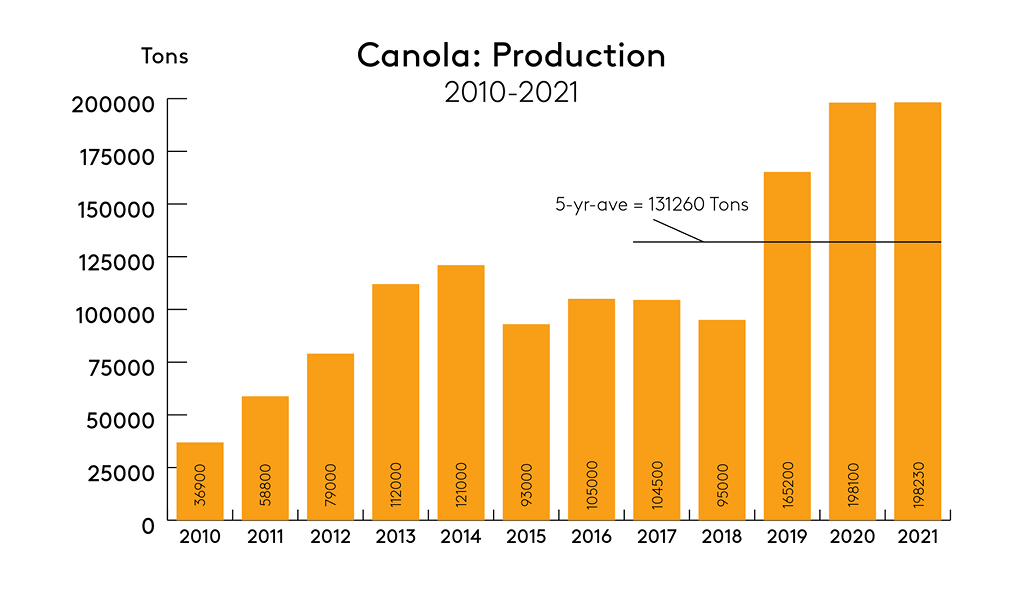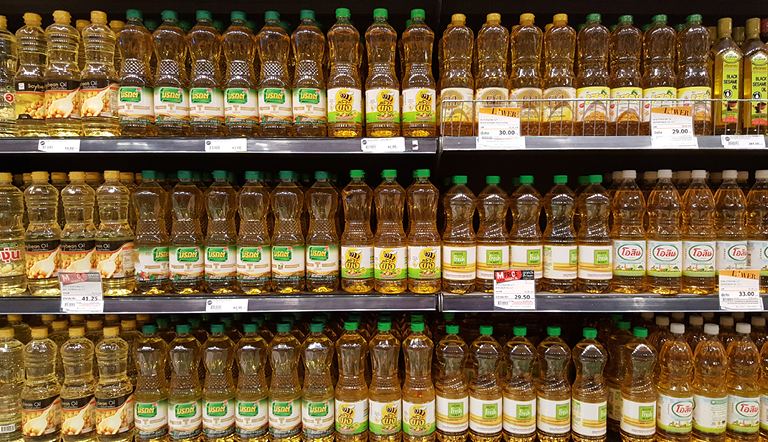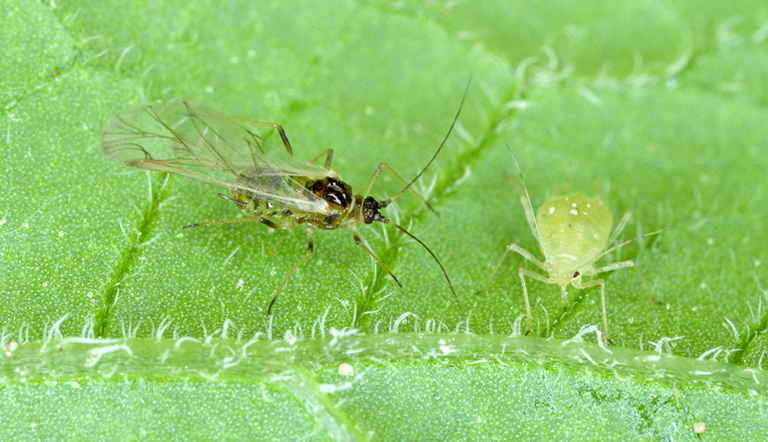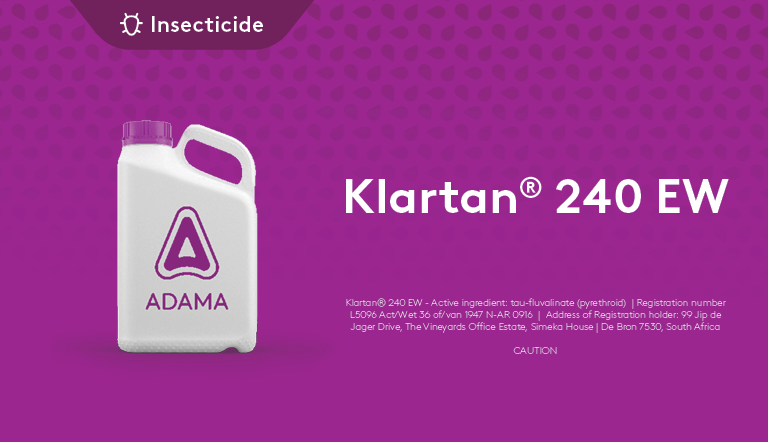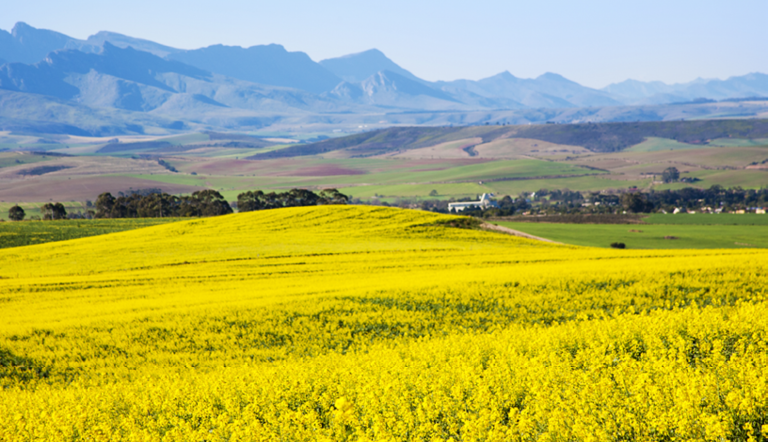
Canola Farming in South Africa

Canola is a brassica crop from the cabbage and mustard family. It is grown for its edible oil. The oil is low in saturated fats and high in monounsaturated fats, which makes it a healthier alternative to other cooking oils on the market. Besides cooking oil, the plant is also used as a livestock feed (the meal being an excellent source of protein and favourable amino acids), fertiliser and in the processing of hydraulic fluid and printing ink.
The oil produced by this cereal is one of the healthiest oils in the world. According to CANSA, it has “zero trans fat and the lowest amount of saturated fat of all common cooking oils. It has been rigorously tested and approved by authoritative scientific bodies for human consumption. In fact, canola oil is recognised as a heart-smart cooking oil by many health organisations.”
Canola farming in South Africa has expanded in recent years due to increases in global demand for canola oil and in August 2022, 121 000 hectares were under canola, up 21% from the previous year. The main producing area is in the Western Cape, where there are over 1,000 canola farmers.
Canola cultivars
The name is a combination of the words “Canada” and “ola,” which means oil. It was originally developed at the University of Manitoba, Canada in the early 1970s from rapeseed cultivars of Brassica napus and B. rapa. Rapeseed was an ancient grain - records show that it was grown in India 3 000 years ago.
“A cultivar is a variant in a species developed through the intervention of humans (despite the term 'variety' often being incorrectly used to describe this) … Cultivar development is a collaborative effort among plant breeders, pathologists, chemists, physiologists, and agronomists, as well as highly trained research technicians, biologists, and support staff. Plant breeders make crosses among promising genetic material, and select for desired seed yield, seed constituent concentrations (e.g. oil or protein, usually expressed as a percentage), and seed quality characteristics (e.g. the presence of specific amino acids and fatty acids.” - Canola Council of Canada)
The cultivar grown in here is B. napus.
As a rotation crop
According to the Canola Council of Canada, “diversified crop rotations can have many benefits, especially with insect and disease management… Rotation can also improve crop yields [in crops that follow canola such as cereals and soybean], increase soil organic carbon and reduce selection for weed resistance. Growers striving for diversity will include cereals, pulses, and oilseeds in their rotations. Some will also add perennial crops.”
Because it is a broadleaf crop, it also introduces diversity and provides an opportunity to use different herbicides.
Rotation is an important part of sustainable farming. Find out more about rotation benefits and planning.
SA Canola - facts and figures
While it is a summer crop in colder regions of the world, the growing season for canola in South Africa is winter, and harvesting takes place in spring. The Western Cape accounts for the majority of SA production, with a small percentage coming from the Eastern Cape, North West and Limpopo.
The ideal soil type is clay-loam that is not prone to wind erosion and has good surface drainage is optimal for growing canola. The life cycle is about 3 ½ months, depending on temperature, moisture, sunlight and soil fertility, and the plants grow to about one metre high.
Believe it or not, canola only became established as a viable crop here in 1996, when SOILL (Southern Oil Pty Ltd) opened the doors of its canola oil refinery in Swellendam. Apart from a dip during and after the Western Cape drought of 2015-2017, the industry has grown immensely. What began with five farmers and 400 ha has now expanded to more than 400 farmers, an estimated 123 510 ha in 2022 and an expected yield of 1,60 t/ha.
Outlook for SA's canola industry
The future looks bright for South Africa's canola industry. With recent record-breaking plantings, opportunities for the export of canola are opening up.
With poor harvests of sunflowers in Eastern Europe and Russia, the cost of sunflower oil soared by more than 40% in some regions.
“Sunflower oil has been most directly affected with an increase of more than 40% since the day of the invasion. It accounts for about 13% of vegetable oils traded in global markets, and Ukraine and Russia account for about 50 and 25%, respectively, of the sunflower oil traded in the world,” noted the International Food Policy Research Institute.
Canola oil is more competitively priced, “which gives us the opportunity to do replacement in traditional sunflower oil markets,” said Kellie Becker, MD of SOILL.
In 2021, Ferdi Meyer and Tracy Davids of BFAP, wrote that “vegetable oils that are used in human diets (cooking oil, margarine, etc.) and animal feeds constitute one of South Africa’s largest categories of processed food imports, with a trade deficit of R8.6 billion in 2020. Palm oil imports are the largest within this category, ranked 5th out of all food and agro-processing imports (Figure 1), with more than R4.5 billion being imported per annum. Palm oil imports have been growing consistently over time, more than doubling from 248 000 tons in 2001 to 525 000 tons in 2020.”
Another opportunity opened up in April 2022, when Indonesia announced a ban on palm oil exports. Where Ukraine produces half the world’s sunflower oil, Indonesia produces half the world’s palm oil.
Another important aspect is the 2021 drought in Canada, which saw canola yields drop by 40% and production falling to the lowest levels since 2007. While this might offer another short-term opportunity for local exporters, the most important long-term result is that the plant breeders at the University of Manitoba are now working on developing heat-tolerant varieties.
Pests and diseases affecting canola farmers
Pests and diseases are a major concern for canola farmers in South Africa. The crop is susceptible to a number of diseases, including blackleg, white rust and Alternaria blight. Scleriotinia has recently emerged as a disease that can result in severe yield losses. These diseases can cause serious yield loss and can jeopardise the crop's quality.
Canola is also susceptible to insect pests, such as the cabbage aphid, green peach aphid and mustard aphids (see our article on How to Prevent Aphids from Ruining Your Canola Crop), as well as the diamondback moth and the cabbage root fly. These pests can cause significant damage to the crop, resulting in yield loss and financial losses for farmers.
Weeds are another threat (for excellent advice, read Early Weed Control for Canola).
ADAMA’s crop protection
Products from ADAMA that can be used for pre-season weed control include Makhro Paraquat, Glyphogan 360 SL and Glyphogan Plus.
Pre-emergence weed control can be managed with ADAMA’s Tylsimex 500 SC, Simanex 500 SC and Atranex 90 WG. All active ingredients in these products form part of the triazine herbicide group. They can only be used on triazine-resistant (TT) canola cultivars.
For post-emergence weed control, ADAMA offers Poquer 120 EC and Agil 100 EC. Both these products will control some annual grasses.
ADAMA’s Warlock® 19.2 EC insecticide effectively controls Lepidoptera larvae, including those resistant to organophosphate, pyrethroids and insect growth regulators. Warlock® 19.2 EC can be used in an IPM programme as the specific pest is targeted and beneficial insects are not affected in any significant way.
Controlling aphids without affecting other beneficial insects is possible with ADAMA’s Klartan® 240 EW. It is effective at low dose rates and has low toxicity for bees and predatory insects. (In some countries it is even registered to control mites in beehives and is therefore suited to an IPM programme.)
For advice on managing other pests and diseases, contact your ADAMA field agent.

